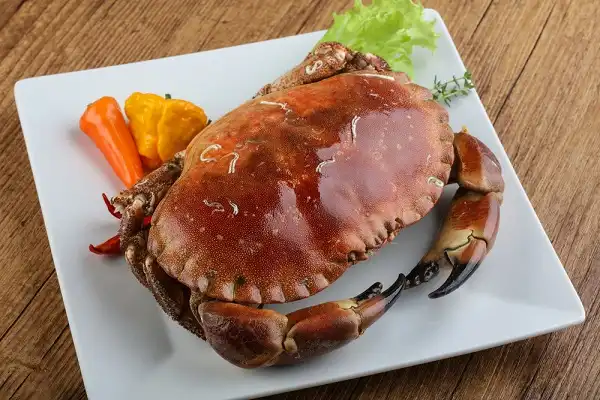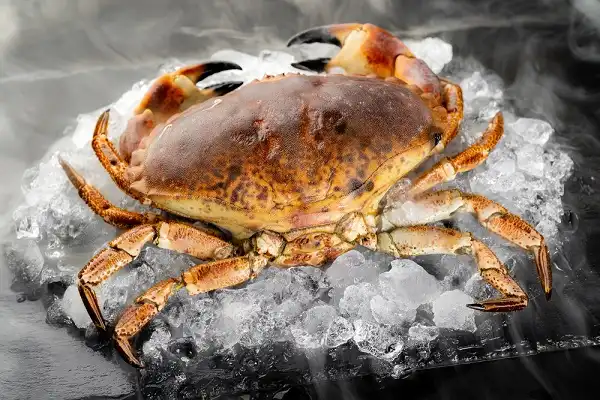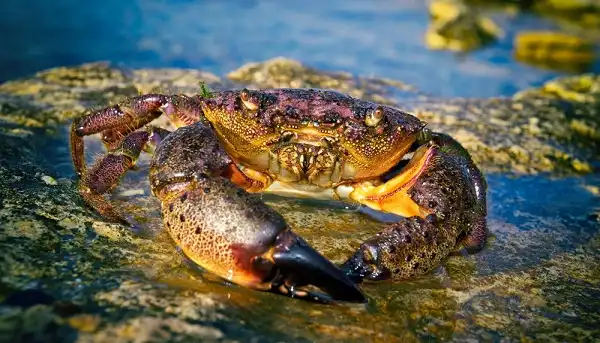Stone crabs, one of the most interesting aquatic animals that inhabit our coastal waters, have been captivating us with their remarkable looks and behavior since before recorded history. Although we may not be able to fully comprehend its complex ecological needs just yet, several different studies have revealed some truly fascinating facts about this incredible animal which can help us understand why these crabs are such an integral part of our marine environment. In this blog post, we’ll dig deeper into the world of stone crabs and explore their anatomy, life cycle, and habitat—so keep on reading if you want to find out more!

Stone Crab Description
Stone crabs, native to the coastal waters of the Atlantic and Gulf of Mexico, are a delightfully interesting species of crab. They’re instantly recognizable by their large, asymmetrical claws and long antennae. These claws are what make stone crabs so distinct from other crabs; they can grow up to 6 inches in length and are used for crushing prey or defending against predators. The claw size is also an important indicator of age for the species; younger crabs have smaller claws due to them not yet being fully grown. The body of a stone crab is covered in a tough exoskeleton which helps protect it from predators but also gives it its remarkable coloring.
The exoskeleton ranges from dark greenish-brown to yellowish-orange with white spots, giving it a unique pattern that makes it easy to identify. The life cycle of a stone crab begins with fertilized eggs being laid by female crabs that hatch into larvae after roughly 12 days at sea. After about two months these larvae transform into juveniles which then migrate inshore and begin burrowing into mud flats or sandy bottoms where they will remain until reaching maturity at 2-3 years old. Once mature, these adult crabs will become territorial and may spend up to 4 years in the same area before migrating again.
Stone Crab Habitat
Stone crabs inhabit a variety of habitats, from shallow muddy or sandy bottoms to deeper waters down to depths of up to 200 feet. They are found in both inshore and offshore waters and live among seagrass beds, coral reefs, and rocky shorelines. Stone crabs can also be found in mangrove forests, estuaries, and tidal flats. These animals prefer warm temperatures, between 68°F (20°C) and 80°F (27°C). They are highly adaptable creatures that are able to survive in brackish environments, as well as salty ocean waters. In the wild stone, crabs play an important role in the marine ecosystem by preying on smaller organisms while providing sustenance for larger predators like birds or fish. They also help keep sand on ocean floors clean by sifting through sediment and looking for food sources. The presence of stone crabs is vital to healthy coastal ecosystems as they reduce water turbidity levels which helps promote crystal-clear water conditions that are beneficial for other aquatic life such as corals and seagrasses.
Stone Crab Diet
Stone crabs have a varied diet that is composed of small mollusks, worms, crustaceans, small fish, and even other larger crabs. They are scavengers that feed on detritus from the ocean floor as well as their own prey sources. In the wild stone, crabs will mostly feed on small organisms such as worms, clams, and shrimp. They also enjoy mollusk shells which are broken down and consumed in order to access the nutritious flesh inside. In addition to these items, stone crabs may also consume larger prey such as other crabs or fish if they can catch them.
Given their size and habit of living near the seabed, stone crabs are also opportunistic scavengers who will eat almost anything they can find such as debris or algae floating around in the water column. Stone crab diet studies have shown that they are capable of digesting a wide range of items including plant matter like seaweed and kelp. The diet of a stone crab changes with its age; younger stone crabs prefer smaller prey like plankton or micro-organisms while older ones may consume larger items like mussels or snails if given the opportunity. Knowing this is important for conservation efforts since it helps researchers understand how different age groups impact the environment around them.

Stone Crab Size
Stone crabs reach an average size of 3.5 inches (9 centimeters) across their carapace, although some individuals can grow up to 6 inches (15 cm). Their carapace is usually a mottled brown color and features nine marginal teeth along the edges. The claws of the stone crab are large and strong and feature sharp points at the tips used for crushing prey or defending itself from predators. Although they may appear small in size, stone crabs are well-equipped to survive in their environments due to their hard shells, strong claws, and elongated legs. They use these body parts not only for protection but also for hunting prey and digging into the sand or mud to hide during the day. The presence of these remarkable creatures is vital to healthy coastal ecosystems as they reduce water turbidity levels which helps promote crystal-clear water conditions that are beneficial for other aquatic life such as corals and seagrasses.
Stone Crab Lifespan
Stone crabs have a relatively short lifespan compared to other crustaceans, usually living between 3-5 years. This is mainly due to the fact that they are a popular delicacy and are often harvested for human consumption. Stone crabs can grow up to an impressive 6 inches (15 cm) across their carapace and are known for having sharp claws which they use both for hunting prey and defending against predators. In the wild, stone crabs have several predators such as seabirds, fish, octopi, sea turtles, and even other larger crabs. To survive in their habitats they rely on their hard shells, strong claws, and elongated legs that help them move through sand or mud while also enabling them to climb rocks with ease. In terms of reproduction, female stone crabs mate during springtime when the water temperature rises above 15°C. After mating the female will lay her eggs within several days before heading off in search of food sources. Once hatched the young stone crab larvae remain pelagic until they eventually settle into their habitat in pursuit of prey.
Stone Crab Behavior
Stone crabs are typically diurnal creatures, spending most of their days foraging for food and scavenging the ocean floor for edible material. During the night, stone crabs hide in crevices or burrows in the sand or mud to avoid predators. While they are solitary animals by nature, groups of stone crabs have been observed congregating in certain areas with plentiful food sources. In addition to feeding activities, stone crabs exhibit other behaviors that are important for their survival such as grooming themselves and burying themselves in the sediment during high tide when they cannot find shelter elsewhere.
Stone crabs also practice “burrowing” which involves digging into soft sediment with their claws and legs to create a tunnel-like structure where they can rest during periods of low tide when their environment is exposed. The presence of these fascinating creatures is vital to a healthy coastal ecosystem as they help reduce water turbidity levels which promote crystal-clear waters beneficial for other aquatic life forms like corals and seagrasses. As strong swimmers who can reach depths up to 40 meters (131 feet) below sea level, stone crabs play an essential role in helping maintain a balance between different species by preying on smaller organisms while being hunted by larger ones.

Stone Crab Speed
Stone crabs are surprisingly quick creatures when they need to be. They can reach speeds of up to 1 meter per second (3.6 feet/second) while swimming on the water’s surface and 0.2 meters per second (0.7 feet/second) while crawling along the ocean floor. This is essential for their survival as it helps them escape potential predators, find food sources, and travel long distances in search of suitable habitats. When it comes to foraging for food, stone crabs have been observed using a combination of short bursts of speed with periods of slower movement in between, allowing them to quickly snatch unsuspecting prey from the surrounding waters or sediment bed before moving on to the next target. It is also believed that this strategy helps conserve energy by preventing them from swimming continuously at high speeds which would rapidly deplete their oxygen reserves and cause fatigue.
Stone Crab Hunting
Stone crab hunting is a fascinating process that involves an impressive set of skills. To find their prey, these crustaceans rely on their keen eyesight to detect movement in the water or on the ocean floor. They then use their sharp claws and legs to quickly snatch any invertebrates like small snails, mollusks, worms, and shrimp within reach before moving on to the next target. In addition to passive hunting techniques, stone crabs have also been seen actively chasing after potential prey when they detect movement in the water around them.
This behavior helps them stand out against many other aquatic predators who typically wait for their prey to come within easy reach before launching an attack. To further increase their success rate, stone crabs have adapted several strategies over time such as digging tunnels through soft sediment in order to remain hidden from potential predators or waiting for high tides when food sources are plentiful. These intelligent behaviors are essential for ensuring that these fascinating creatures stay well-fed and safe from harm in their marine environment.

Conclusion
Stone crabs are fascinating creatures that play an important role in the health of marine ecosystems. Their impressive swimming speed and sharp claws enable them to quickly snatch unsuspecting prey while also allowing them to swiftly escape potential predators or find suitable habitats for shelter. Furthermore, their ability to burrow through sediment and reach depths up to 40 meters (131 feet) below sea level makes them well-adapted to their marine environment. All of these traits combined make stone crabs an essential component in maintaining a healthy balance between different species and help ensure that our aquatic ecosystems stay healthy for years to come.
Frequently Asked Question


